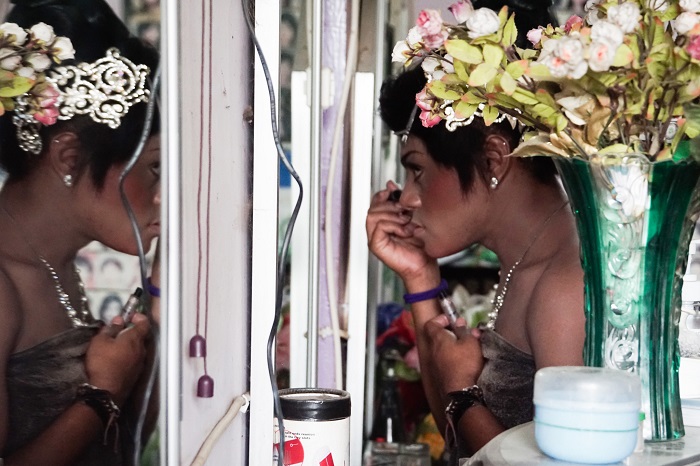Papuan waria draw on foreign ideals of beauty in their quest for a sense of belonging in their local communities
Terje Toomistu
Five hours before the opening of the West Papuan waria beauty pageant, the salon of the Sorong community elders was busy with preparations. Among 10 to 15 waria – Indonesian male-bodied individuals who feel like women and often claim to have the soul of a woman – an indigenous Papuan waria whom I call Sakti was getting ready for the long-awaited night. One of the elders was doing the hair, another creating spectacular make-up for all the contestants. The few intense hours of checking facial expressions in front of mirrors, putting on glamorous dresses and practicing walking in high heels were eased with jokes and mimicry.
Sakti looked at herself in the mirror, struck a pose and announced in English: ‘Leila Lopes from America!’, imitating the voice of an MC on an imaginary stage. The fact that in 2011 the annual Miss Universe pageant crowned Miss Angola, 25-year-old Leila Lopes, the winner is well known among waria of Sorong, a thriving coastal city at the tip of the Bird’s Head Peninsula of West Papua. However, Sakti in her act, that was nothing short of spectacular, positioned the body of Leila Lopes, and subsequently herself, into America. She asked another waria to apply a light powder on her upper back, but checking herself in front of the mirror again, she still asserted with dismay: ‘Chocolate’.
When I first met Sakti during my ethnographic fieldwork with waria in various parts of Indonesia, she used to be one of the very few indigenous waria in the Sorong community. She appeared shy and insecure, but made efforts to hide it. She was often labelled as the ‘Miss Angola’ by others for her relatively darker skin, but she rather strived for the title of ‘Miss Mexico’. Her dream was to open her own hair salon but in the meantime she financed her life with transactional sex, just like her friends. When returning home, she prayed for her sins.
The world of waria in Papua
Compared to most other regions in Indonesia with long histories of gender transgressive practices and identities, the emergence of waria in Papua is a fairly recent phenomenon. It counts as one of the effects of making Papua more ‘Indonesian’ since its incorporation into the state in the 1960s, followed by the government-initiated mass migration into the area. Since then, waria from neighbouring islands have moved to Papua, seeking life experience and better economic prospects. These circumstances, along with wider social change, have recently attracted an increasing number of indigenous Papuan waria to the community. The latter is also the case with Sakti who had run away from home in Biak at the age of 19 because her step-father was beating her.
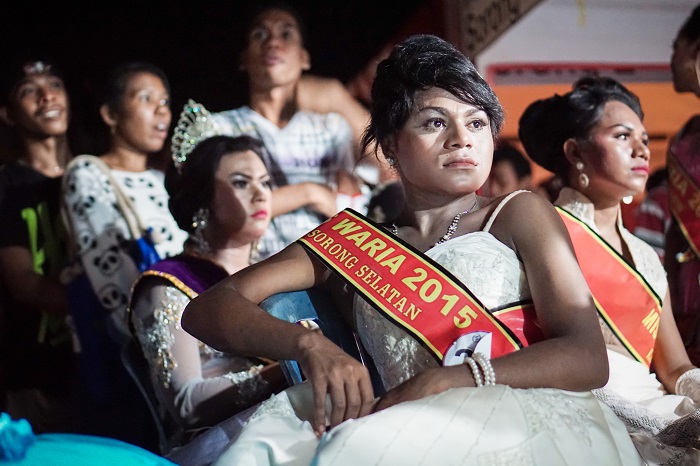
‘Since childhood I have really wanted to become [a waria],’ Sakti recounted. ‘I already felt that I was indeed a woman, so I ran alone to Sorong here, then entered “the world of waria”.’
Waria across the archipelago often use the term ‘the world of waria’ (dunia waria) when describing the social and imaginary lifeworld of waria. As a response to their limited social acceptance, ‘the world of waria’ forges a sense of belonging and equips waria with various attributes from ways of dressing, talking and applying make-up, to skills needed to survive, and the knowledge to navigate cultural activities such as beauty pageants, community meetings and advocacy work. In Papua, this ‘world’ has been fostered by the more experienced migrant waria, who usually arrive from regions that have longer traditions of active community work and possess more experience in salon work as well as in street nightlife that frequently includes sex work. These migrants largely set the context in which indigenous Papuan waria forge a lifestyle and construct their sense of self.
A couple of years after leaving home Sakti had become a central figure in Papua’s waria community. She had won the second prize at the beauty pageant and worked in a salon as often as she could alongside her exuberant nightlife activities, which she now seemed quite to enjoy. She had also cultivated her complexion, using whitening products and protecting herself from the sun – like many other Indonesians, including women, waria and men – and she was able to look back at the time when she was in her own words ‘hitam sekali’, or very dark.
Sakti was also far from being the only indigenous Papuan on the scene. Coming from the rural area where she was persecuted, she had found comfort in the waria world of Sorong, following its social milieu, trajectories and activities on her own journey of becoming. ‘The world of waria’ was the locus of becoming for her and at once a community to belong to.
However, the quest for belonging also shapes the perceptions of embodied beauty. Against the backdrop of the differences in appearance between indigenous Papuans of Melanesian origin with their relatively darker skin, stockier bodies and curly hair, and the migrant population characterised by the smaller Malay body type and straight hair, indigenous Papuan waria such as Sakti crave for the kinds of beauty tied to lighter skin colour and straight hair. This is aligned with the dominant Indonesian ideals of beauty, making the waria community in Papua an interesting case through which to reflect on Indonesia’s racialised notions of beauty and their effect on actual lives.
Beauty and progress
Since its incorporation into Indonesia, Papua has undergone rapid development. At present the migrant population has considerably outnumbered the indigenous population in many regions. The continuous economic and social dominance of the settlers, the militarisation of the region, and the standards of beauty in the rest of the country have resulted in various forms of diminishment of indigenous Papuans, including Papuan waria. Indigenous Papuans have been often depicted as people who are somehow backward.
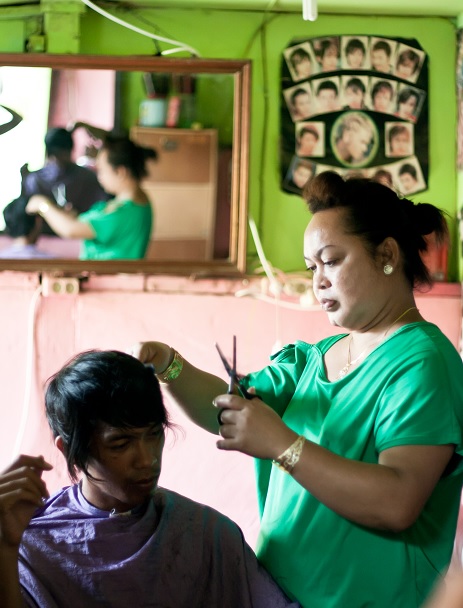
In 1961, when the region of West Papua was still under Dutch control, the New Guinea Council decided on their official name Papua, which etymologically denotes the frizzy hair of Papuans in contrast to the straight hair of the majority of Indonesians of Indo-Malay descent. Today, the physical differences between the newcomers (orang pendatang) and indigenous Papuans (orang asli Papua) are constantly accentuated in the widespread use of vocabulary such as ‘straight hair’ or ‘curly hair’ in daily speech. However, these practices go hand in hand with the Indonesian agenda of modernity, which in turn appears to advance the idea of self-cultivation towards the indigenous Papuans.
The discriminatory practices on one hand and the Indonesian discourse of modernisation on the other have consequently contributed to the formation of certain embodied notions of what it means to be ‘successful’. No wonder then that the word ‘amber’ in the Biak language (Sakti’s native language), which describes foreign non-Papuan people and literally means ‘straight hair’, has recently gained another layer of meaning: a successful or rich person. It is clear that the powerful discourse of modernisation has influenced the understanding of beauty in Papua, which is now inherently tied to the idea of progress (maju).
The majority of waria in Papua work in salons, which implies an active engagement with beauty. Salon work provides a promising field for financial security for waria travelling to Papua. Migrant waria in Papua who work in salons often look back and describe their circumstances in Java and Sulawesi in terms of tough competition and limited income, while in Papua, the ‘money is good’ and the market is growing. Waria migration to Papua and other areas of rapid urban development is further boosted by the context of modernisation in which beauty is understood as requiring significant effort and conscious intervention. In these settings, waria have successfully established their niche in the beauty business.
‘So if no one would accept waria,’ says Donna, a waria in her 40s describing the important role of waria in Papuan salon business, ‘they would not be able to advance (maju), the city could not become progressive (nggak bisa maju kota itu), the city could not flourish, yes, it would remain the same forever.’
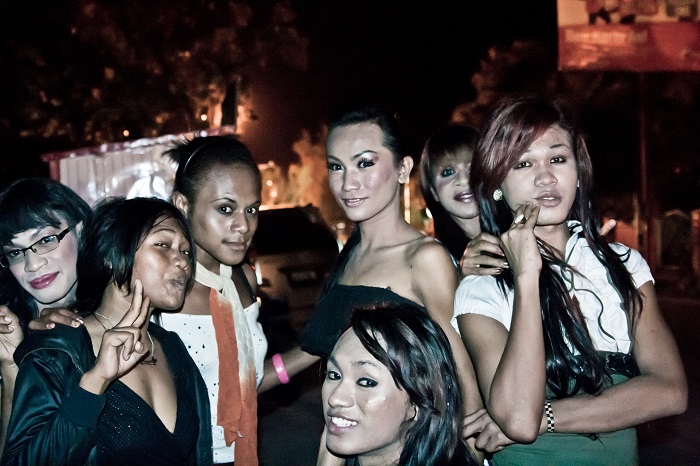
Here Donna links the presence of waria and their salon services, which cultivate imported beauty standards, with Papua’s potential for development, and this link serves waria in more ways than one. In Papuan cities the daily salon work of waria often involves straightening the hair and lightening the skin of the Papuan population, to align with popular Indonesian beauty ideals. Indeed, hair straightening is often a salon’s most expensive service, which Papuan women nevertheless flock to and admire on one another. As agents of beauty, waria therefore transform the indigenous Papuan people into more ‘progressive citizens’, closer to the image of the advancing Indonesian nation. Therefore, waria use the conventions of beauty as resources not only to earn a living but also to strive for national belonging by using their skills to contribute to national advancement.
Striving to belong
How beauty is organised and understood and what kind of beauty feels engaging is always bound to specific cultural histories. Following the association of modern femininity with the cultivation of body and looks, over decades waria-gendered expression became closely tied to the expression of beauty. This is how the practice of make-up (dandan, or déndong in waria slang) turned into one the foundational aspects of what makes one a waria. Hence beauty for waria is not only a way of embodying femininity and one’s sense of gender: it is also a group identifier.
In Papua, the idea of progress has evolved as part of national ideas of modernity and rapid changes during the integration of the region into the Indonesian state. Here, the image of success tied to the imagined West as the locus of progress, and to the imagined community of Indonesia, permeates perceptions of what is a progressive, successful or beautiful look. The aspired beauty follows the Indonesian dominant ideal, which in turn references the feelings of cosmopolitanism and transnationalism – the reasoning behind Sakti’s performative positioning of herself into imaginary America. The glamorous enactments of beauty and spectacular femininities are often based on imagined ties with possessors of ideal beauty such as ‘Miss Mexico’, ‘Miss Netherlands’, Cinta Laura or Britney Spears. These playful engagements illustrate the ways in which waria participate in and draw resources from wider cosmopolitan culture to affirm their sense of self, as a result of which, however, they are often prosecuted. The imagined mobility within these kinds of performances have the capacity to detach the subjective experience of waria from the harsh conditions that normally surround them.
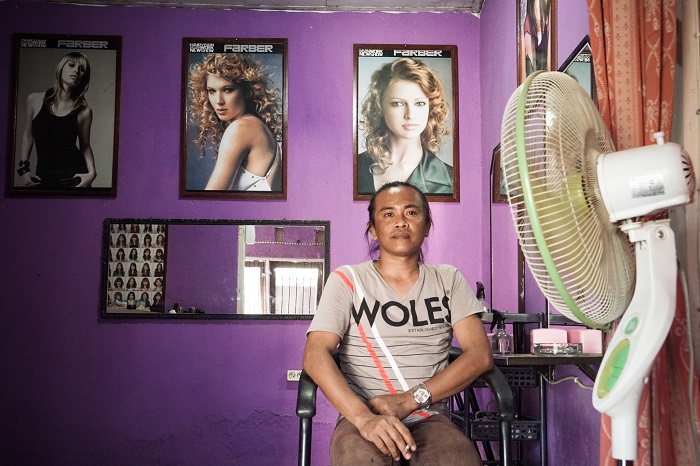
For waria, these kinds of playful performative practices enable new forms of kinship and senses of belonging to the imagined worlds of the global as well as the national. Meanwhile, they also beneficially position waria in terms of possible local audiences, such as men in the nightlife context, or the local Papuan population whose acceptance they aspire to, or the migrant waria, whose recognition matters for indigenous waria. Thus, waria draw from meaningful symbolic resources in their practices of beauty to create senses of belonging on the transnational or national scale in order to strive for belonging in their local communities.
Proud Miss Papua
While the imaginary connections to faraway symbols, places and idols enable a sense of belonging, this does not mean that belonging is an easily achieved status for waria. Rather, these are some of the strategies used in order to cope with their precarious existences. In addition, these pursuits of belonging are not equally achievable for all waria at all times. Racialised ideals of beauty as well as age affect waria differently. Indigenous Papuan waria also have to navigate the intersecting circumstances of gender and racialised ideals of beauty. These standards of beauty are far beyond being simply a question of taste and class aspirations, because beauty for waria is also a group identifier, which facilitates their legibility as waria, as subjects, like women, in society.
Sakti’s craving for a label other than ‘Miss Angola’ and positioning of herself into an imaginary America hint at the perceived hierarchies in forms of embodied beauty. These hierarchies subsequently influence her sense of self-worth and also structure her potential for belonging. Needless to say, she is not the only one. In order to feel loved and accepted, young indigenous waria struggle to act out beauty according to the Indonesian norm. The same can be noticed about many Papuan women. What might it take for them all one day to become proud ‘Miss Papua’, embracing their frizzy hair and beautiful bodies?
Terje Toomistu (terjetoomistu@gmail.com) is a post-doctoral research fellow at the University of Tartu, Estonia. Her doctoral research focuses on the community of waria from the perspectives of feminist anthropology. She is also one of the authors of a documentary film ‘Wariazone’ (2011).
